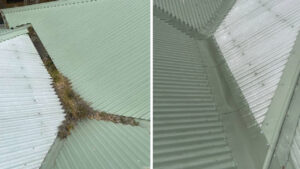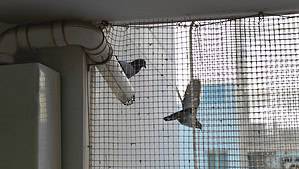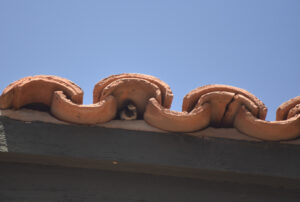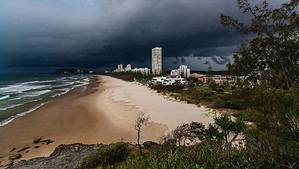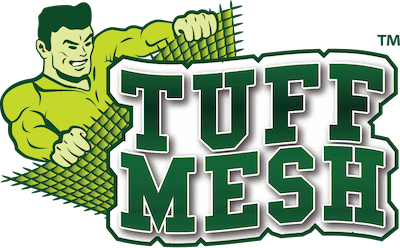“Imagine waking up to fluttering and chirping, only to discover a family of birds has turned your gutter into their new home. This isn’t just a nuisance; it can lead to clogged gutters, water damage, and even affect your home’s structural integrity.”
In Australia, where diverse bird species abound, residential areas often become unintended nesting grounds. While birds are a vital part of our ecosystem, their nesting can create significant maintenance challenges for homeowners, from blocked gutters and damaged solar panels to unsightly droppings and noise disturbances.
This guide delves into practical bird-proofing solutions that prevent these issues and respect natural wildlife. We’ll explore various products and strategies effectively used across Australia to safeguard homes from pesky pigeons, aggressive mynas, and other avian intruders.
Join us as we discuss the essentials of birdproofing, which can help you maintain a safe and serene living environment. We will also discuss how you can keep your property secure and welcoming—with the right kind of guests.
Bird Proofing Product Types
So, what are the most common bird-proofing products in Australia? Effective birdproofing involves using various products designed to deter or prevent birds from nesting and roosting in undesirable areas. The most common Australian bird-proofing products include:
- Physical Barriers, including gutter guards, solar panel mesh, and covers
- Bird Spikes
- Netting and Wire Systems
- Audio Deterrents
- Visual Deterrents
- Chemical Repellents
Speak to us about getting bird-proofing your home.
Physical Barriers
There are various forms of physical barrier protection either professionally installed or easy installation for DIYers. Here are the most common physical barriers used in bird control and prevention:
- Gutter Guards: Not all gutter guard products are equal regarding bird control—brush gutter guards, foam inserts, and stainless steel mesh panels are often less effective. A gutter guard system installed correctly prevents pest birds from nesting in the gutters while allowing water to pass through. Gutter protection systems installed by professionals block access to vents, eaves, and roof cavities, providing ultimate and long-term protection. Learn more about how gutter guards provide bird protection.
- Window Screens and Vent Covers: These prevent birds from entering homes through windows or ventilation systems, particularly useful in urban areas where birds might seek shelter.
- Solar Panel Mesh: Specifically designed to protect solar panels from birds and debris, this mesh is installed around the perimeter of solar panels. It prevents birds from nesting under the panels, which can lead to damage and reduced efficiency. To learn more about our Solar Mesh product, visit our solar mesh product page.
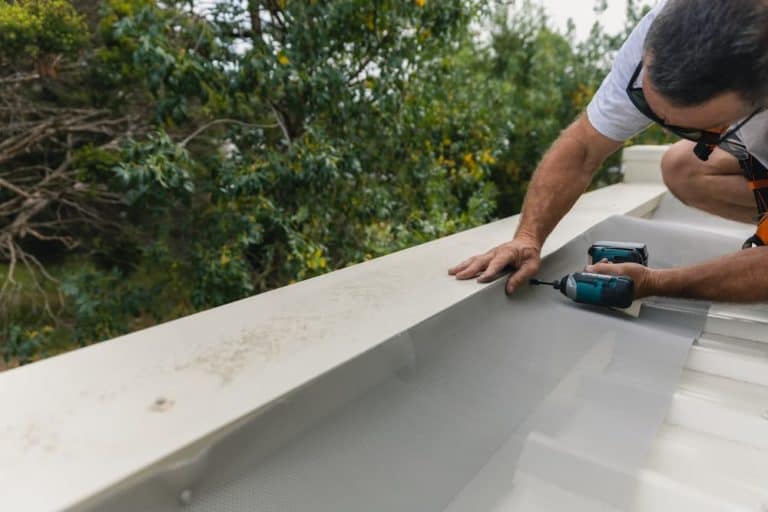
Bird Spikes
These long, needle-like rods make surfaces uncomfortable for birds to land on without causing harm. They are used on ledges, signs, and rooftops to prevent perching and roosting.

Netting and Wire Systems
Netting and wire systems, though less commonly used in residential settings, are prevalent in commercial, agricultural, and industrial environments due to their visibility and extensive coverage area. These methods effectively deter birds but require thoughtful installation and regular maintenance to ensure they continue to function effectively and safely.
- Netting: Netting creates a physical barrier that prevents birds from accessing these spaces to nest and roost. It is most often used in settings like agricultural fields, vineyards, and around commercial buildings where large areas need protection.
- Wire Systems: Wire systems involve tensioned wires strung across buildings to prevent birds from landing. This method is particularly suited for preserving the aesthetic integrity of historic buildings or any structure where minimal visual impact is desired.
To learn more about the difference between gutter guard and bird netting, read our article, “Gutter Guard vs. Bird Netting: What’s the Best for Bird Proofing?“
Audio Deterrents
- Sonic Devices: These devices emit natural bird distress calls and predator sounds to scare birds away, effective in open areas like farms and orchards. Studies have found these become less effective over time.
- Ultrasonic Devices: These emit sounds at frequencies higher than humans can hear but disturbing to birds, suitable for enclosed spaces like warehouses.
Visual Deterrents
- Reflective Tapes: These tapes reflect sunlight in patterns that disorient birds and are commonly used in gardens and on fruit trees.
- Decoys and Scare Balloons: Models of predatory birds or shiny, moving objects that can be used to scare away smaller birds, often used with other methods.
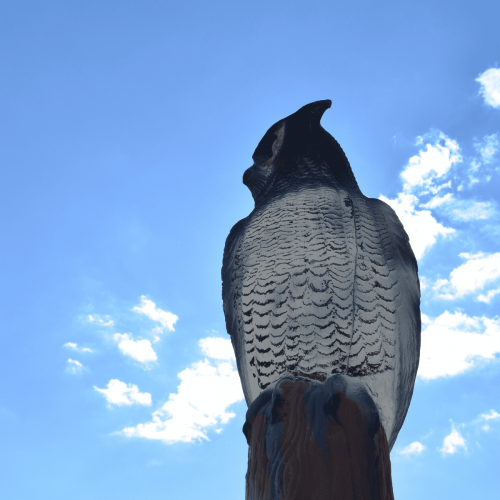
Chemical Repellents
These substances are designed to be unpleasant for birds without causing harm, used as a last resort or in combination with other methods. They must meet stringent Australian standards to ensure they do not adversely affect the local wildlife or environment.
While individual bird-proofing products can be effective on their own, in most cases, homeowners find that a mix of different products yields the best results. This combination approach ensures that all potential entry points and attractants are addressed, providing a comprehensive solution to bird problems.
Home Areas Requiring Bird Proofing
The most common areas homeowners need to bird-proof to prevent damage and maintain cleanliness:
- Gutters, Roofs, Eaves, Fascias, and Soffits
- Solar Panels
- Roof Voids and Valleys
- Chimneys
- Air Conditioning Units and Vents
- Windowsills, Ledges, and Balconies
- Garages and Carports
- Outdoor Living Areas (Patios, Pools, Verandas, Pagodas)
- Gardens and Sheds
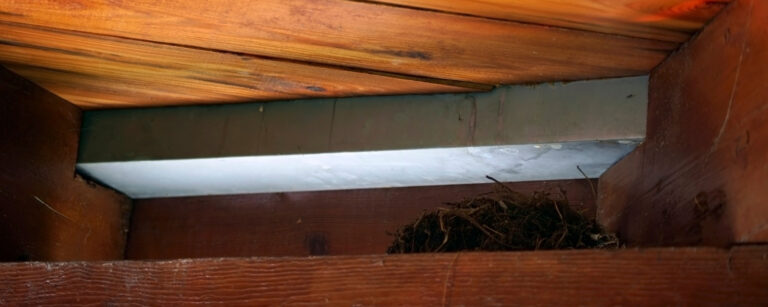
Birds have commonly targeted gutters, roofs, eaves, fascias, and soffits, which provide sheltered spots perfect for nesting. However, in the past five years, solar panels have become the most attractive nesting sites for birds, particularly pigeons, which nest underneath and can damage the panels or impair their efficiency. Additionally, roof voids, valleys, and chimneys are attractive nesting spots that can lead to blockages and structural damage. Birds often nest atop or underneath air conditioning units and infiltrate vents, creating noise disturbances and potential malfunctions. Windowsills, ledges, and balconies are typical perching points that can become unsightly due to bird droppings.
Open structures like garages and carports, as well as outdoor living areas—including patios, pools, verandas, and pagodas—often host birds, affecting their cleanliness and use. Finally, gardens and sheds can suffer from bird activity, where birds may damage plants or building structures. Each of these areas may require specific bird-proofing strategies to protect the property and maintain a clean and safe environment.
Common Australian Pest Birds
In Melbourne, five bird species are known for causing significant issues in urban and rural settings, including:
- Feral Pigeon
- Seagulls or Silver Gulls
- Sparrows
- Starlings
- Indian or common Mynas
Effective bird-proofing strategies must consider these species due to their nesting habits, potential for damage, and health risks. Read more details about how to bird-proof against these species in our article “Bird-proofing in Melbourne.”
Feral Pigeons
Known as one of the most troublesome birds in urban environments, pigeons are prolific all year round. They are highly adaptable and often depend on human environments for food, making them frequent visitors to residential areas where they nest in gutters, downpipes, and solar panels. Their droppings and nesting materials can block drainage systems and pose fire hazards, especially when they build nests under solar panels.
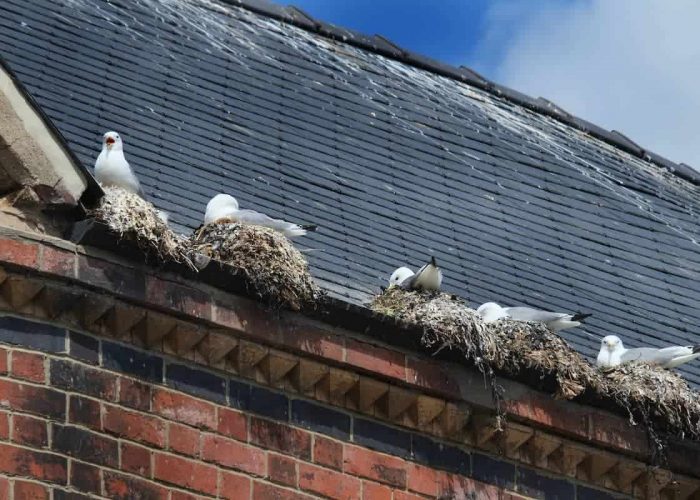
Seagulls or Silver Gulls
Commonly found in coastal areas and increasingly moving inland, seagulls nest on flat roofs, gutters, and under solar panels. Their droppings are acidic and can cause structural damage over time, and their presence in large numbers can lead to significant mess and noise.
Sparrows
This includes both the House Sparrow, an introduced species, and the Welcome Sparrow, a native variety. However, the House Sparrows cause the most trouble as their small size gains them access to roof cavities or under eaves to build nests, leading to persistent noise and mess. Welcome Sparrows can cause some issues as their mud nests can cause nesting litter around your home. They often nest in sheltered areas like sheds, carports, garages and verandas, so limiting access is crucial. Sparrows’ ability to adapt and breed in urban environments makes them a persistent issue for homeowners.
Starlings
Another introduced species, starlings, are social birds that roost in large numbers and can cause extensive damage with their acidic droppings. These droppings corrode building materials and contaminate rainwater systems. Starlings are known to displace native birds and dominate urban and rural habitats.
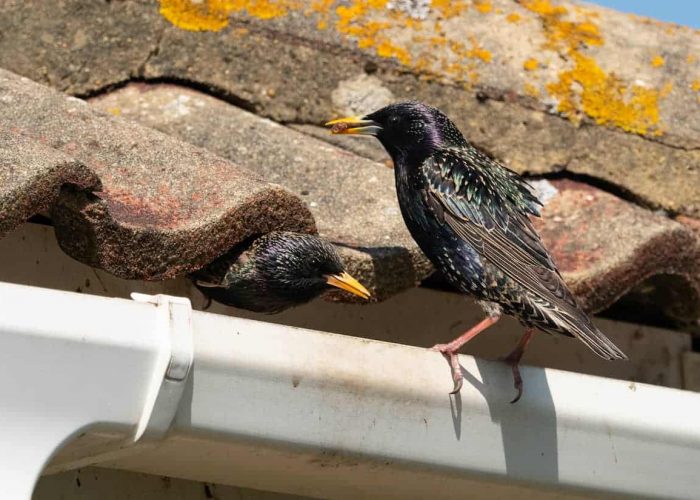
Indian or Common Mynas
Notoriously aggressive and noisy, mynas compete with native species for nesting sites. They often nest in roof cavities, eaves, and other small hollows around homes, bringing noise, mess, and sometimes mites and other pests.
Each species presents unique challenges, requiring tailored bird-proofing solutions to mitigate their impact effectively. Homeowners should consider a combination of physical barrier protections, such as netting and gutter guards, and other deterrents, like spikes and visual scares, to protect their properties from these avian pests.
Speak to us about getting bird-proofing your home.
Comparative Analysis of Bird Proofing Methods
| Bird Proofing Method | Pros | Cons | Ethical Considerations | Effectiveness |
|---|---|---|---|---|
| Physical Barriers | Prevents access to nesting sites | Can be visually intrusive | High | Non-lethal, humane |
| Bird Spikes | Effective deterrent for perching | Limited to flat surfaces | Moderate | Non-lethal, humane |
| Netting & Wire Systems | Covers large areas | Requires maintenance; risk of birds getting tangled | High | Requires careful installation to be humane |
| Audio Deterrents | Can cover large open areas | Effectiveness decreases over time | Moderate | Non-lethal, some species may habituate |
| Visual Deterrents | Simple to install | Birds may habituate | Low to Moderate | Non-lethal, humane |
| Chemical Repellents | Can be applied to specific areas | Potential environmental impact | Varies | Use as a last resort; potential harm to wildlife |
Physical Barriers
Gutter Guards
Gutter guards are designed to prevent birds from accessing and nesting in gutter systems. They act as a physical barrier that helps prevent the buildup of leaves and debris, which can attract birds. Installing gutter guards ensures that water flows freely, reducing maintenance and avoiding damage to the building’s foundation. While highly effective in blocking bird access, gutter guards may require an initial investment and periodic cleaning to maintain their effectiveness.
Window Screens and Vent Covers
These barriers block birds from entering through windows, vents, and other openings. They are instrumental in urban settings where birds seek entry into buildings for shelter or food. Screens and covers are generally easy to install and do not significantly alter a building’s aesthetic appeal. They provide a humane way to prevent birds from entering and nesting in undesirable areas.
Solar Panel Mesh
Specifically designed mesh can be installed around solar panels to prevent birds, particularly pigeons, from nesting underneath. This nesting can lead to significant damage and reduced efficiency of the solar panels. Solar panel mesh is tailored to ensure that it does not impede the operation of the panels while providing robust protection against birds.

Bird Spikes
Bird spikes are a straightforward method to deter birds from landing on ledges, rooftops, and other flat surfaces. They are effective for preventing birds from perching and are widely regarded as a humane option because they do not harm birds but merely discourage landing. However, their use is limited to specific areas and is unsuitable for covering larger or uneven surfaces. Learn more about the effectiveness of bird spikes in our article, “Gutter Guards vs. Bird Spikes: Which is best?”
Netting and Wire Systems
Netting provides a comprehensive solution for larger areas such as agricultural fields, vineyards, and commercial properties. It acts as a complete barrier against birds, preventing them from accessing areas where they might feed or nest. Wire systems, consisting of tensioned wires placed across flat surfaces, prevent birds from landing and are less visible than netting, making them suitable for historic buildings or other areas where aesthetics are a concern. Both methods require careful installation and regular maintenance to prevent birds from getting tangled, which could lead to injuries.

Netting and Wire Systems
Audio deterrents, including sonic and ultrasonic devices, emit sounds that are unpleasant to birds but not harmful. These are effective in large open spaces like farms and can be an excellent initial deterrent. However, birds may become habituated to the sounds over time, which can reduce the effectiveness of these systems.
Visual Deterrents
Reflective tapes, decoys, and scare balloons can create temporary disturbances that deter birds from specific areas. While simple and inexpensive to implement, their effectiveness is generally limited, as birds can quickly adapt to static visual cues.
Chemical Repellents
Chemical repellents are used less frequently due to concerns about their environmental impact and potential harm to both target and non-target species. These repellents should be used judiciously and typically as a last resort when other humane methods are ineffective.
Most Effective Bird Proofing Measures
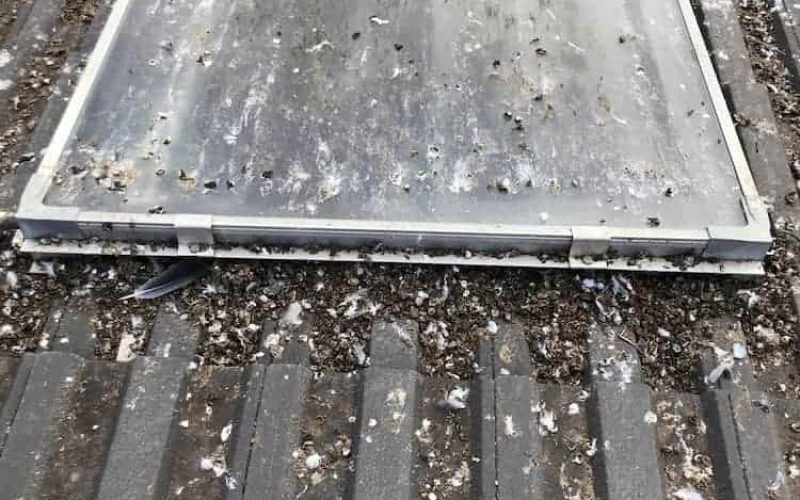
The most effective bird-proofing measure often depends on the specific circumstances, including the bird species involved, the area that needs protection, and the homeowner’s preferences. For instance, gutter guards may be ideal for preventing birds from nesting in gutters, while netting might be necessary for protecting larger areas like orchards or vineyards. Typically, a combination of bird-proofing methods yields the best results, addressing multiple facets of bird behaviour and deterring them from settling in protected areas. This multi-faceted approach enhances effectiveness and contributes to a humane and environmentally responsible bird control strategy.
Read more about how Aussie Gutter Protection offers a comprehensive bird-proofing solution.
Speak to us about getting bird-proofing your home.
Gutter Guard Installation Process for Bird-Proofing
Implementing a robust bird-proofing strategy is crucial to prevent these issues, and one of the most effective methods is the installation of gutter guards. Here, we outline the installation process for gutter guards and barriers for bird-proofing. Here’s how AGP installs gutter guard to residential homes, “Gutter Guard Installation.”
Step-by-Step Guide to Installing Gutter Guards
- Inspection and Planning: Initially, professionals conduct a thorough inspection of the property, focusing not only on the gutters and roof but also identifying all potential bird entry points and areas likely to attract nesting, including examining roof voids, eaves, vents, and other secluded spots. This step is crucial as it ensures that the chosen gutter guards and additional protective measures will fit perfectly and comprehensively cover all vulnerable areas, effectively preventing birds from nesting anywhere on the property.
- Cleaning the Gutters: Before installation, cleaning out the gutters, roof and other areas before applying the physical barrier is crucial. This involves removing any debris, leaves, and existing nests. This step ensures the gutter guards can be installed on a clean, smooth surface, enhancing their effectiveness.
- Measuring and Cutting: Gutter guards are measured and cut according to the lengths of the gutters. Accurate measurement is vital to cover the entire gutter system without leaving any gaps that birds could exploit.
- Securing the Guards: The guards are then securely fastened to the gutters and roofline. This may involve snapping them into place or using screws to ensure they stay firm against weather conditions and prevent birds from lifting them.
- Final Inspection and Adjustments: After installation, a final inspection is carried out to check for any gaps or misalignments. Adjustments are made as necessary to ensure complete coverage and functionality.
Importance of Professional Installation
For bird-proofing solutions, homeowners should consider the benefits of professional consultation and installation, including:
- Expertise and Efficiency: Professional installers have the necessary skills and experience to ensure that the gutter guards are installed correctly. Their expertise helps in avoiding common installation errors that can compromise the effectiveness of the guards.
- Safety: Installing gutter guards involves working at height, which can be hazardous. Professionals are equipped with the proper safety gear and training to perform the task safely.
- Warranty and Reliability: Professional installation often comes with a warranty, both for the product and the installation workmanship. This assurance provides homeowners with peace of mind, knowing that their investment is protected.
- Tailored Solutions: Professionals can provide customised solutions that cater specifically to the architectural nuances of your home and the specific bird challenges you face.
How to Install Solar Panel Mesh
Solar panels are quickly becoming a pest to birds, especially pigeons, which are the favourite nesting place. Protecting your solar panels with solar panel mesh is an essential step to protect your investment against bird-related damage. However, installing solar panel mesh is a delicate process that, when done correctly, preserves the integrity of your solar panels and ensures they continue to operate efficiently. Learn how to prevent bird damage to your solar panels with our article, “9 ways to stop birds nesting under solar panels.”
Installation Process:
- Inspection: A thorough site inspection determines the best installation strategy.
- Material Selection: Durable, UV-resistant mesh tailored to your specific needs.
- Secure Attachment: Mesh uses clips that fit onto the existing solar panel structure, requiring no drilling.
- Quality Check: A final inspection confirms the installation is secure and effective.
Why Professional Installation Matters
The installation of solar panel mesh is a delicate process that, when done correctly, preserves the integrity of your solar panels and ensures they continue to operate efficiently. Here’s why you should seek bird
- Warranty Preservation: Many solar panel warranties could be voided if the installation causes damage. Professionals ensure that the installation is done without drilling or altering the solar panels, thus keeping your warranty intact.
- Prevent Damage: Incorrect installation can lead to physical damage not only to the solar panels but also to your roof. Professionals use the right tools and techniques to avoid any harm.
- Expert Assessment: Professionals will evaluate your specific situation to determine the best type of solar panel mesh and the most effective installation method. They take into account factors such as the type of birds in the area, the configuration of your solar panels, and the local environment.
Hiring Aussie Gutter Protection to install Solar Mesh on your solar panels ensures the job is done correctly and your solar investment is protected. Remember, the cost of professional installation is minimal compared to the potential loss in energy efficiency and the risk of damage associated with improper installation of solar panel mesh.
See how AGP professionally installs bird protection on solar panels.
Bird Control Products Maintenance
Ensuring the long-term effectiveness of bird-proofing products involves regular maintenance and care. Proper upkeep not only extends the life of these products but also maintains their efficiency in deterring birds from nesting and roosting in undesired areas.
Here are key tips on maintaining various bird-proofing systems:
Regular Inspection:
- Frequency: Inspect bird-proofing installations at least twice a year, ideally during spring and autumn when birds are most active in building nests.
- What to Look For: Check for any signs of damage, such as loose fittings, tears in netting, or bending and rusting in spikes. Ensure that all physical barriers like gutter guards and vent covers remain intact and securely in place.
Cleaning Guidelines:
- Physical Barriers: Gutter guards and solar panel meshes should be cleared of leaves, twigs, and debris that can accumulate and impede their functionality. Use a hose to wash away any buildup.
- Spikes and Netting: Remove any nesting materials or droppings. Use a brush or cloth to wipe down each spike for bird spikes. For netting, a gentle wash with soapy water can help maintain its condition without harming the material.
- Audio and Visual Deterrents: Ensure that devices like sonic emitters are free from dust and debris that might block their speakers. Check that visual deterrents like reflective tapes or decoys are not faded and are securely fastened.
Safety Recommendations:
- Protective Gear: When cleaning or inspecting bird-proofing products, especially in high areas like roofs, use appropriate safety gear, including gloves, eye protection, and a secure ladder or scaffold.
- Avoid Chemical Cleaners: For cleaning bird-proofing materials, avoid harsh chemicals that can degrade the materials and harm the environment. Instead, opt for mild detergents or simply water.
- Professional Help: If any part of your bird-proofing system requires repair or replacement, consider hiring a professional, especially for complex systems like electronic deterrents or when working in difficult-to-reach areas.
Long-Term Care:
- Replacement and Upgrades: While most bird-proofing products like netting and spikes may require eventual replacement due to wear and tear, gutter guards are designed to last without replacement. Read our article, “How long do gutter guards last?” They are a long-term solution that, with proper installation and occasional cleaning, should not require frequent updates. However, staying informed about new bird-proofing technologies and materials can provide opportunities to enhance or complement your existing solutions with more efficient or aesthetically pleasing options.
By following these maintenance and care tips, you can ensure that your bird-proofing measures remain effective and durable, protecting your property from bird-related damages over the long term. Regular care helps maintain the structural integrity of your home and contributes to a safe and clean living environment.
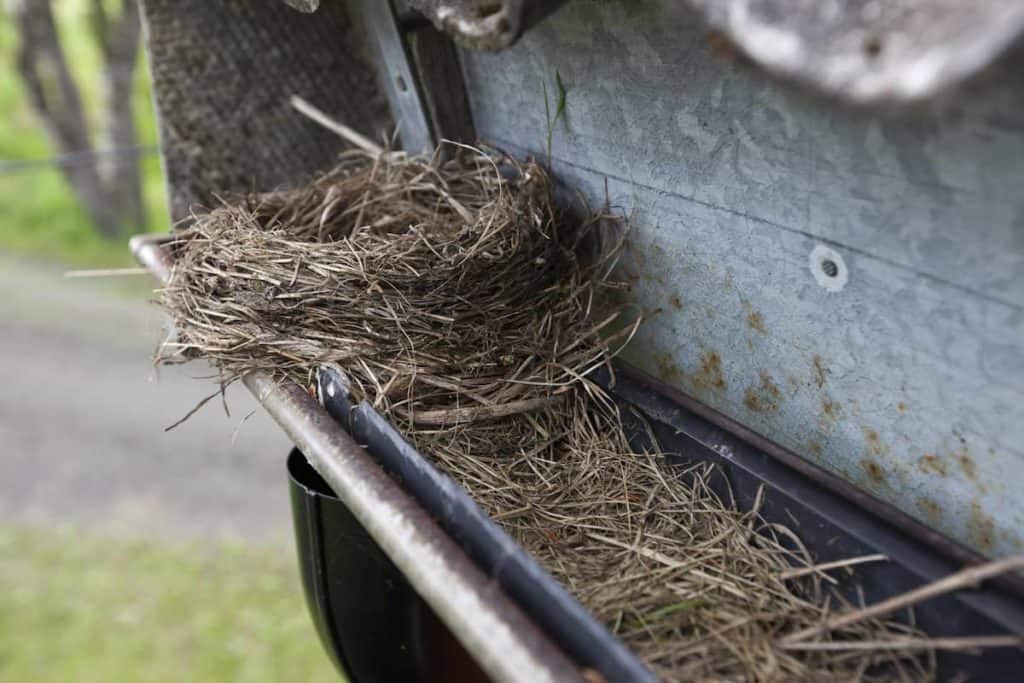
Legal and Ethical Considerations of Bird Proofing
What are the legal and ethical considerations of birdproofing? Wildlife protection laws in Australia dictate that it’s illegal to harm or interfere with bird nests actively in use. Ethically, it’s crucial to use bird-proofing methods that deter rather than harm, ensuring the safety and welfare of the birds while protecting your property.
Effective strategies often focus on prevention, incorporating physical barriers that restrict access to potential nesting sites without causing harm to the birds. This approach not only complies with legal standards but also ensures the humane treatment of wildlife, helping to preserve bird populations while protecting buildings and structures from damage. For further guidance on adhering to these regulations and implementing ethical bird-proofing methods, please refer to our detailed article “Is it illegal to remove birds’ nests from roofs?”.
Cost Considerations for Bird-Proofing Solutions
Below is a quick comparison of DIY versus professional bird proofing solutions, highlighting costs and benefits. For a more detailed analysis on each bird proofing product and the advantages of DIY vs. professional installation, please refer to our article “How much does bird proofing cost?”
| Aspect | DIY Bird Proofing | Professional Bird Proofing |
|---|---|---|
| Cost Per Metre | $10 - $25 | $30 - $40 |
| Installation | Self-installed, time and effort required | Installed by professionals, includes warranty |
| Long-Term Effectiveness | Potentially lower due to risk of improper installation | Higher, more reliable due to professional quality |
| Overall Investment | Lower upfront, potential for higher long-term costs | Higher upfront, more cost-effective in the long run |
| Property Protection | Less guaranteed protection | Comprehensive and lasting protection against birds nesting in gutters and home |
This table offers a clear, at-a-glance summary that helps homeowners make informed decisions about bird-proofing options. The linked article provides all the necessary details for those interested in exploring specific products or installation method pricing.
Case Studies and Success Stories
Gutter guards have proven to be an excellent solution for bird proofing by establishing a physical barrier that prevents birds from nesting in gutters, while still ensuring proper water flow. Beyond just deterring birds, gutter guards offer several significant advantages.
Hear from Our Customers:
Angela shares her experience, “AGP installed a gutter guard about 18 months ago, and we’ve been really happy with it for keeping the pesky myna birds out.”
Tania explains her decision, “Our neighbours built a new double-storey next door, and within six months, they had huge weeds growing in their gutters. After seeing this, installing gutter guards seemed like a no-brainer, especially given the large trees around our property, including a massive pine tree at the back of our house.”
Andrew recommends AGP, “If you need to keep out pests, leaves, and other debris, I would strongly recommend AGP. This is now the third house I have had Brendan work on, and their installer, Mitch, did a great job again. For the best results, go with the best team, and that’s AGP.”
For those interested in further information on how gutter guards can help with bird-proofing in Melbourne, click here to learn more.
Frequently Asked Questions About Bird Proofing
1. What is the most effective bird-proofing method for residential properties?
The most effective bird-proofing method for residential properties typically involves installing physical barriers like gutter guards or solar panel mesh. These solutions provide a durable, non-invasive, and humane way to prevent birds from nesting in areas that could lead to damage or require frequent cleaning. However, the most comprehensive approach includes a mixture of multiple bird control solutions.
2. Are bird-proofing measures harmful to birds?
Bird proofing measures like spikes, netting, and visual or audio deterrents are designed to be humane. They deter birds without causing harm, focusing on preventing access rather than physically removing or injuring the birds.
3. How often should bird-proofing measures be inspected and maintained?
Bird proofing measures should be inspected at least twice a year, ideally during spring and fall, to ensure they remain effective and are in good condition. Regular maintenance helps to prolong the life of the proofing measures and ensures they continue to function as intended.
4. Can I install birdproofing measures myself, or should I hire a professional?
While some bird proofing measures can be installed DIY, such as basic spikes and netting, professional installation is recommended for more complex systems like gutter guards and solar panel mesh. Professionals ensure that the installation is correct and effective and does not violate any local wildlife laws or building codes. Contact Aussie Gutter Protection today to get a free bird-proofing consultation and quote.
5. What should I do if birds are already nesting in my gutters or roof?
If birds are already nesting, waiting until the nesting season is over before removing nests is important, as disturbing active nests may be illegal. Afterwards, installing preventive measures like gutter guards or spikes can help prevent future nesting. For more information about the laws around bird nest removal, read our article, “Is it illegal to remove a bird nest from my roof?”
6. Will bird control measures also remove native birds from my property?
Bird control measures are designed primarily to deter, not remove. Properly chosen and installed, they should not significantly impact native birds or remove them from your property. Instead, these measures prevent nesting and roosting on your structures while allowing birds to remain in the local environment.
7. What issues are caused by pest birds?
Birds foul gutters and solar panels with corrosive droppings, block downpipes with nesting litter, create odours and noise, harbour mites & bacteria, and attract vermin.
8. Which species are the main culprits around Victorian roofs?
The most persistent are Indian mynas, starlings, pigeons, sparrows and introduced parrots such as rosellas; all will exploit small gaps under tiles or panels.
9. How does gutter-mesh bird-proof my home?
A fine 4 mm (or smaller) steel or aluminum mesh is fixed from the roof-edge to the gutter-lip, sealing the eaves line so birds cannot gain a toehold to nest.
10. Do I need a professional, or can I DIY?
For two-storey homes or tiled roofs we strongly recommend professional installation; AGP installers are height-safety accredited and guarantee leak-free sealing. For a 100% bird-proofing solution, we recommend a professional installation.
11. How long does installing bird-proofing take?
A typical single-storey house is completed in ½ – 1 day; larger or multi-storey roofs may take up to two days. (same answer used on page 7)
12. What warranties are offered?
You receive a 10-year workmanship guarantee and up to a 25-year product warranty on the mesh and trims.
13. Will it stop other pests such as possums or vermin?
Yes, the same mesh aperture that blocks birds also deters rodents, possums and large insects from entering roof voids.
14. Can the mesh be colour-matched to my roof?
AGP stocks 25 Colorbond® colours so the aluminium trim blends in discreetly.
15. What maintenance is needed afterwards?
An annual visual check and a light hose-down of any surface dust is usually all that is required; no more seasonal nest removal.
Final Thoughts
Bird-proofing is an essential practice for maintaining the structural integrity and cleanliness of properties while also protecting wildlife. By understanding the most effective bird-proofing methods and implementing the right measures, homeowners can prevent pest birds from causing damage without harming native bird populations. With various options available, from gutter guards to solar panel meshes, each property can be tailored to meet specific needs, ensuring that bird-proofing is both effective and humane.
Ready to protect your home from unwanted bird nests and maintain a wildlife-friendly environment? Contact our experts today to discuss your bird proofing options or schedule an installation. Our team is equipped to provide you with the best solutions tailored to your property’s needs, ensuring long-term effectiveness and compliance with wildlife protection laws. Don’t wait—take action now to safeguard your property and support your local ecosystem!
Aussie Gutter Protection is a leading professional gutter company, working with high-quality materials; products GutterMesh, TuffMesh, SteelMesh and SolarMesh; installation methods for leaf guard, bird proofing, rainwater harvesting, bushfire prevention and protection for solar panels. AGP offers professional installation at affordable pricing to keep your gutters clean and ensure rainwater flows freely. Get a free consultation that brings you one step closer to ridding yourself of clogged gutters.



